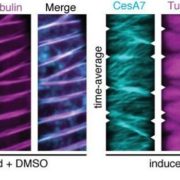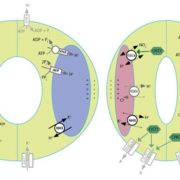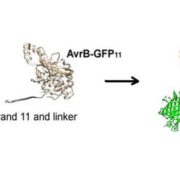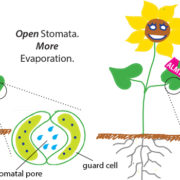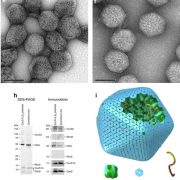A phosphoinositide map at the shoot apical meristem in Arabidopsis thaliana (BMC Biol.)
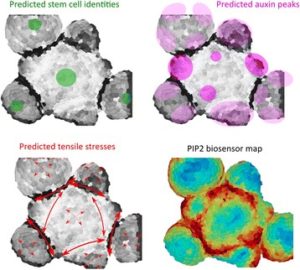 Plasma membrane lipids including phosphatidylinositol phosphates (PIPs) are often depicted as forming a featureless plane that serves mainly as a barrier, but in reality they show considerable spatial diversity. PIPs contribute to anchoring and positioning proteins and protein networks, so there is much to be learned by mapping their dynamic distributions. Stanislas et al. used fluorescent proteins that bind to specific PIP forms including PI4P and PI(4,5)P2 to map PIP dynamics at the shoot apical meristem. The authors observed a relatively low abundance of PI4P and PI(4,5)P2 in the central zone and enhanced levels in the organ boundary zones. To investigate a functional role for this pattern, the authors examined both PIP and meristem mutants. Their results suggest a positive correlation between PI(4,5)P2, cortical microtubules, and mechanical stress at the SAM. This study highlights the potential role for PIPs as mediators of patterning through interactions with the cytoskeleton and/or mechanosensors, as has been suggested in animal cells. (Summary by Mary Williams) BMC Biol. 10.1186/s12915-018-0490-y
Plasma membrane lipids including phosphatidylinositol phosphates (PIPs) are often depicted as forming a featureless plane that serves mainly as a barrier, but in reality they show considerable spatial diversity. PIPs contribute to anchoring and positioning proteins and protein networks, so there is much to be learned by mapping their dynamic distributions. Stanislas et al. used fluorescent proteins that bind to specific PIP forms including PI4P and PI(4,5)P2 to map PIP dynamics at the shoot apical meristem. The authors observed a relatively low abundance of PI4P and PI(4,5)P2 in the central zone and enhanced levels in the organ boundary zones. To investigate a functional role for this pattern, the authors examined both PIP and meristem mutants. Their results suggest a positive correlation between PI(4,5)P2, cortical microtubules, and mechanical stress at the SAM. This study highlights the potential role for PIPs as mediators of patterning through interactions with the cytoskeleton and/or mechanosensors, as has been suggested in animal cells. (Summary by Mary Williams) BMC Biol. 10.1186/s12915-018-0490-y


